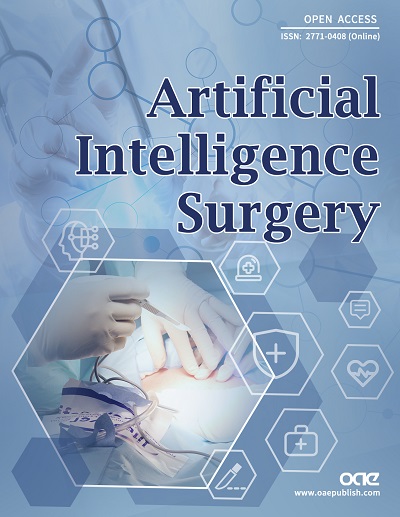Special Interview with Prof. Franca Melfi--President of SIET and Past Thoracic Domain Chair of EACTS
Recently Prof. Franca Melfi, the pioneer in the field of robotic surgery, is co-interviewed by Dr. Sara Parini from Azienda Ospedaliero-Universitaria Maggiore della Carità di Novara (Novara, Italy) and Dr. Elisa Sicolo from University Hospital of Pisa (Pisa, Italy). Dr. Parini and Dr. Sicolo are invited authors for the special issue “Women in Surgery Meets AIS Journal”. The Editorial Office of the AIS journal presents some highlighted questions of the interview, which shares Prof. Franca Melfi's surgical background and her remarkable insights.
Prof. Melfi explains why she approached robotic surgery over 20 years ago and how continuous technological evolution in surgery like Artificial Intelligence has made her surgical journey more fascinating. She also takes into account the fact that women are still the minority in the traditional male-dominated surgical world. She believes that the interaction between natural and artificial intelligence, man and machine, and the concrete way they relate is the most exciting area in digital surgery.
Q1: What reasons led Prof. Franca Melfi to approach robotic surgery more than 20 years ago?
My interest in robotics began early in my career as a thoracic surgeon. The late 1990s were times of great turmoil in the surgical field. I, somewhat by chance, got involved in technology applied to surgery with a focus on minimally invasive surgery. This led me, almost physiologically, to robotic surgery. In 2001, I was a young assistant in the Cardiothoracic Department, where one of the first Robotic Systems in Europe had been acquired to develop a minimally invasive cardiac surgery program. The robotic surgical systems at that time were rather rudimentary, so it was not easy to perform complex thoracic or cardiac surgery. The beginnings were not easy, partly because there were no dedicated training programs yet, especially in thoracic surgery. That was the beginning of my journey, bumpy at times but undoubtedly full of opportunities, excitement, and satisfaction. It was the beginning of what I have been able to accomplish over the years, from the mentoring activity that I still practice in Europe as well as in Italy to the opening of the Center that I have the privilege of directing and that I share with many colleagues, students and young surgeons who attend it daily.
Q2: What fascinates Prof. Franca Melfi today?
The continuous technological evolution in surgery implies constant updating, which means new challenges, ongoing research, and training. One example of this is the latest robotic platforms which integrate multiple technological domains so much that today we are increasingly talking about digital surgery, that is, a surgery that includes Artificial Intelligence, cloud computing, and augmented reality, as well as 3D virtual imaging and much more. I believe we are just at the beginning of a real revolution in surgery that will imply a paradigm shift and new challenges that continue to make this long journey of mine more fascinating.
Q3: Does Prof. Franca Melfi think the traditional male-dominated surgical world is evolving? Where are female surgeons in that process?
The first woman physician to practice surgery lived in the early 1800s. James Barry was the male name Miranda Stuart had to use to gain access to the surgical profession. Her true identity as a woman was only discovered when she died. Today, more than half of physicians in training are women. Yet, they represent only around ten percent of surgical specialists, and their steady increase in medical schools does not reflect the number of female doctors in surgical specialties. Therefore, women continue to be a minority. However, a recent review by the Royal College of Physicians found that women contribute positively to medical practice and are willing and able to assume essential management roles; nevertheless, there are still difficulties in promoting women in the surgical field.
Many ask me whether, at the beginning of my professional journey as a young woman, I experienced prejudice. I must say that when I started, I did not dwell much on this aspect. I always went on, even though I often felt like constantly walking uphill. Looking back, I do not doubt that a gender gap somehow directed my choices. However, paradoxically, it positively impacted my career path.
Q4: How does she think robotic surgery can play a role in closing the gender gap?
I believe this technology can certainly create conditions for reducing gender differences. As it is well known, robotic surgery originated as remote surgery. Everyone is familiar with the first transoceanic surgery, performed in 2001 and named " Lindbergh operation", in honor of the first pilot who flew across the Atlantic. The use of these platforms, together with the surgical simulators that are now an integral part of training programs, have created the conditions for the spread of surgical techniques no longer "one to one" but "one to a thousand." This implies that experts from all over the world can be involved to spread their expertise, teach remotely (telementoring) and, in the future, potentially perform surgeries remotely (telesurgery). This "democratization of surgery" can also substantially impact gender equality. It is evident how the possibility of teaching remotely and especially to more individuals simultaneously leads to overcoming stereotypes that have caused the well-known barriers and glass ceilings to persist for years.
Q5: So far, the application of artificial intelligence-based technologies is limited, even in robotic surgery, which is frequently associated with the concept of artificial intelligence. What are the most exciting applications that could be implemented in the coming years?
The theme is much broader than only artificial intelligence; we should speak of the Digital sector, which includes artificial intelligence, big data, machine learning, and all those technological concepts discussed today, from neural networks to robotics to Analytics. In summary, digital surgery. Looking to the future, one of the most exciting areas is the interaction between natural and artificial intelligence, man and machine, and the concrete way they relate.
Q6: How does prof. Franca Melfi envision the evolution of robotic training for surgeons in the coming years?
The use of algorithms makes it possible to simulate surgical procedures and implies the possibility of predicting potential difficulties by preventing possible adverse events. This is extremely useful for young and experienced surgeons as it creates the conditions for greater surgical accuracy from which patients can benefit.
In the coming years, we will undoubtedly have gradually less cumbersome platforms with smaller and more advanced instrumentation. The new generation of robots will be able to quickly simulate surgery planned for the next day. Still, they will be platforms that are increasingly integrated with the most advanced technologies, including pathological analysis technologies that will allow "real-time" analysis of the tissue to be resected so that we will be moving toward more precision surgery.
As described by the Lancet Commission 2015, we are facing a global shortage of more than 140,000 billion/year of surgical procedures and a related lack of more than 2 million surgeons. I believe it will be possible to reduce this unbalance through advanced technologies, such as robotics and digital surgery, which, among other things, can create the conditions for reducing the gender training gap.
Q7: Thanks to machine learning, does prof. Franca Melfi think it will come to surgery that can be autonomously performed by the robotic system, only supervised by the surgeon?
This will never happen. Its gestures are mechanical, while the mind is that of the clinician. It is the latter who gives it the correct information. The human factor is always decisive. We are still in charge of the machine. Moreover, we will never completely forget the use of the scalpel, and it should also be clarified that robotic surgery does not mean applying a different surgical technique; the surgical steps are the same, and therefore, the gestures, although mediated by the robotic instruments, are identical to the "traditional or open" gestures. Indeed, we will collaborate more and more with biomedical engineers and computer scientists, but I am confident that robots will never do anything without humans.
Q8: What will be her next professional challenge?
The THEATER Institute (Translational institute for High Education, Advanced Technology, and Experimental Research for Medicine and Surgery) is a project I have worked on for some years. It is an institute under the auspices of the University of Pisa, whose purpose is to develop a unique platform for research and highly qualified training paths. This project will constitute a node in the global network of universities and research institutions through public and private collaborations. In this international training center, the activities will be characterized by dedicated training paths with virtual and physical simulators. The THEATER Institute will be the seat of Level II "Robotics" Masters as well as one of the few reference centers in Europe, accredited for tutoring and proctoring, a hub for training and technological innovation involving all disciplines in the development of high technology applied to medicine, from computer science to biology, from engineering to physics. I am betting a lot on this project, the mission behind it, and its vision for the future. I hope it can be realized soon.
Biography of the Interviewee

Professor Franca Melfi is paving the road for women in thoracic surgery in many ways. She is the Chief of Multispecialty Robotic and Thoracic Minimally Invasive Center and Associate Professor of Thoracic Surgery at the University Hospital in Pisa. She has been the first woman to serve as president of SIET (Società Italiana di Endoscopia Toracica) and Thoracic Domain Chair of EACTS (European Association of Cardio-Thoracic Surgery).
During her early career, one stands above all the outstanding achievements that can be highlighted. She was the first surgeon in the world to perform robotic pulmonary lobectomies in 2001. After those pioneer operations, she completed over 3,000 robotic thoracic procedures, becoming one of the world’s most renowned robotic thoracic surgeons. Currently, her research interest focuses on the application of high technology in Robotic Surgery, the standardization of procedures, and clinical application in the field of Thoracic Surgery.
Thanks to Dr. Sara Parini and Dr. Elisa Sicolo for sharing the interview with Prof. Franca Melfi. Editorial Office of Artificial Intelligence Surgery Journal would like to share more excellent experts’ forward-looking voices in the future.
Respectfully Submitted by the Journal Editorial Office of Artificial Intelligence Surgery







